
The Crocker was built heavy duty for maximum performance, custom-tailored to the individual rider's order, and built in Al Crocker's own facility. Each buyer could choose color, degree of chrome trim, and even gear ratio and displacement.
Al Crocker founded Crocker Motorcycles in 1936, having spent 20+ years honing his skills engineering and designing bikes for Indian. Al and his former foreman at Indian, Paul Bigsby (who later went on to invent the famous Bigsby tremolo for guitars) knew they had the muscle and know-how to give the competition a serious run for their money. When Crocker introduced their first hand-built speedway racer bikes, they flat-out killed the competition, not just sweeping the boards– setting new standards for performance and quality that far exceeded Harley-Davidson, Indian and everyone else for years to come. They reigned as the baddest bikes around until 1942, when the company folded– unable to support it self due to a slow build time, material shortages brought on by the war, and an economic downturn. Incredibly, only around 100 bikes were produced during this time, but the legend and fervor lives on– with Crocker being among the rarest and most coveted motorcycles in the world to this day.
At the MidAmerica Auctions motorcycle auction in January 2007 in Las Vegas, a 1941 Crocker big tank (equipped with a 3 gallon cast aluminum fuel tank) motorcycle sold for $230,000. At the Gooding & Co. auction in 2006 in Chandler, a 1931 Crocker 61 sold for $236,500. At the Bonhams & Butterfield 2006 auction in New York, a 1937 Crocker “Hemi-head” V-Twin brought $276,500. At the 2006 auction of Bator International in California a 1939 Crocker 61 cubic-inch side valve model sold for $200,000.
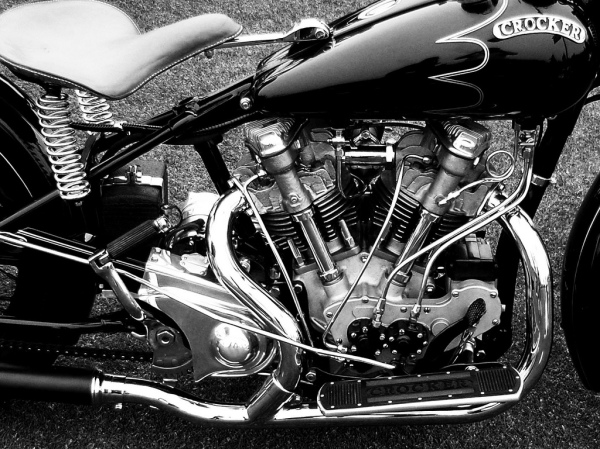
Crocker introduced motorcycle design innovations that set his V-twin ahead of the Harleys and Indians of the mid 30's and 40's. The transmission could withstand incredible amounts of torque. This beautifully engineered three speed transmission coupled with a unique proprietary engine of Crocker's own design laid shame to anything that dared cross its path.
So confident was Crocker with this magnificent machine that he offered to refund the full purchase price to any buyer who was beaten by a rider on a factory stock Harley or Indian bike.
No refund was ever given.
Crocker introduced motorcycle design innovations that set his V-twin ahead of the Harleys and Indians of the mid 30′s and 40′s. The transmission could withstand incredible amounts of torque. This beautifully engineered three speed transmission coupled with a unique proprietary engine of Crocker’s own design laid shame to anything that dared cross its path. Featuring overhead valves, Crocker’s engine was released to the public months ahead of Harley’s venerable “Knuckle Head” with more than enough horsepower to keep it ahead of the Harley crowd. The Crocker’s zero to sixty mph first gear score murdered all competition. The hemi head equipped stock machines peaked at 60hp propelling the factory produced, stock bikes, to speeds in excess of 110 mph. Even hopped up bikes couldn’t come close.
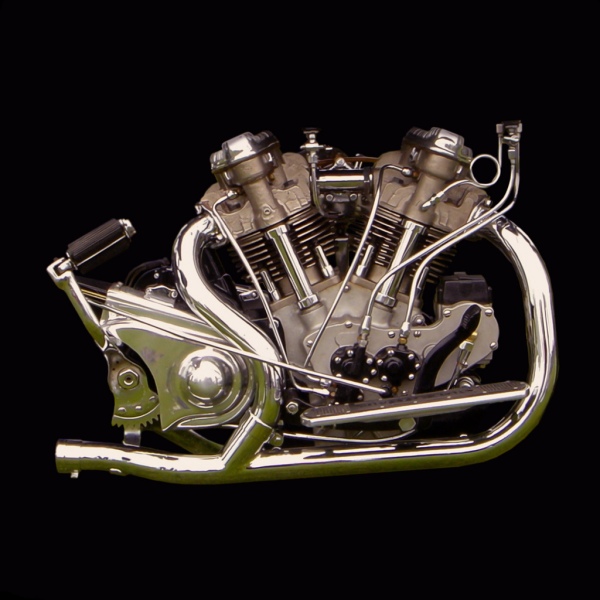
At 3.25" Bore and 3.625 Stroke, the 61 cubic inch engines were almost square. Cylinders were set 45 degrees apart. The compression ratio was rated at 7:1 on most machines but was known to go at least to 11:1 on some specials. The machine was put together with customizers in mind, too. The cylinder walls were a full 3/8-inch thick to allow for over-boring. This led to the creation of some big-bore Crockers of over 90 cu. in. that blew off anything in their way.

3-speed suicide shifter

A beautiful 1934 Crocker 'Big Tank' V-twin
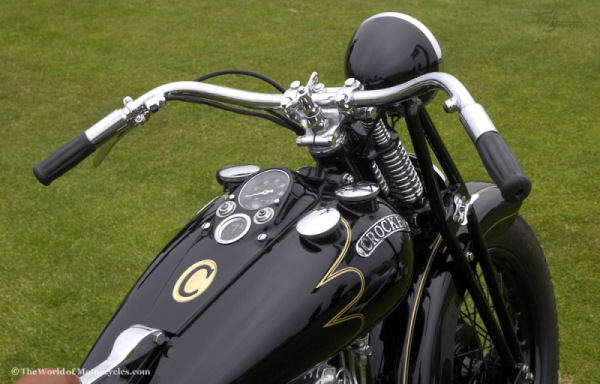
Clean, spartan lines are a part of the Crocker's beauty
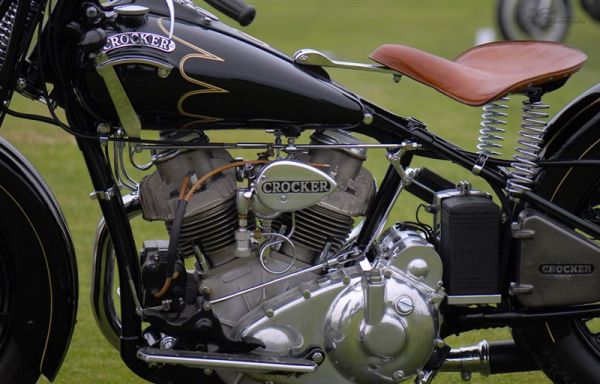
1934 V-twin Crocker 'big tank' that simply put-- crushed the competition.
Definitely the wickedest example of a modern renovated Crocker is Jeff Decker’s ‘bobber’ below. B&W pic courtesy of Falcon Motorcycles–
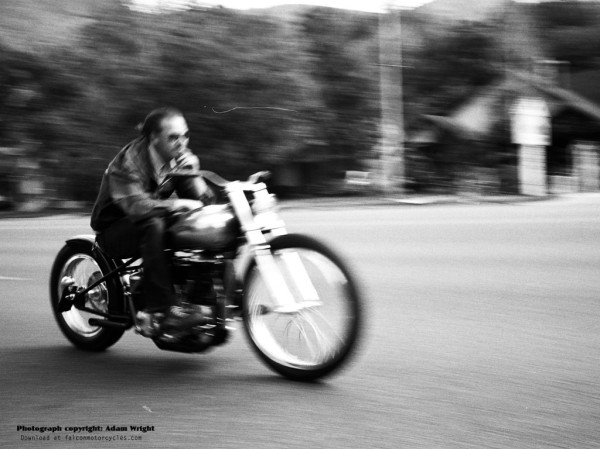
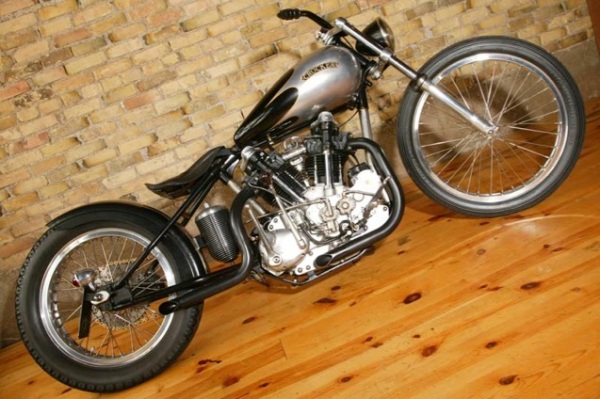

Crocker Motorcycles reemerged in 1997, when they first began to produce parts out of sheer love for the machine. After an enthusiastic response to the few high quality parts Crocker had produced for one of America’s top restorers, and with inquires from original Crocker owners, it was decided to officially incorporate Crocker Motorcycle Company in January 1999. Crocker now produces full vintage reproduction bikes, and in 2007 presented the world with a modern day homage to founder Al Crocker, the C4 Concept–

Designed by Daryl R. Tearne, for the Crocker Motorcycle Co. The C4 gets its name from being the 4th model in the Crocker lineup, after the “Speedway”, the “Small Tank” and finally the “Big Tank”. In conceiving the C4, the objective was to build a modern Crocker the way Al. Crocker himself would have done it if he was still with us today. Some design elements and even some parts were inspired by the original design and incorporated into the new C4. Things like a chassis design with the same original concept but a much more high tech approach. The Headlight’s styling is very similar in shape, but integrates a very modern 7-lens xenon projector lamp into the body. The single sided front fork was inspired by aircraft landing gear. By using this type of front-end setup, the front end is much more narrow and stiffer under heavy braking. By using Penske suspension, and designing rake angle adjustments in the front end, Crocker will be able to offer a custom fit for all customers.The Single sided rear swing arm has also some very unique design features. Body styling use old Crocker elements and alloy accents taken from the Big and Small Tank original models (like the alloy air intakes on the front of the tank). This concept bike will be built to order by Crocker Motorcycle Company.
No comments:
Post a Comment